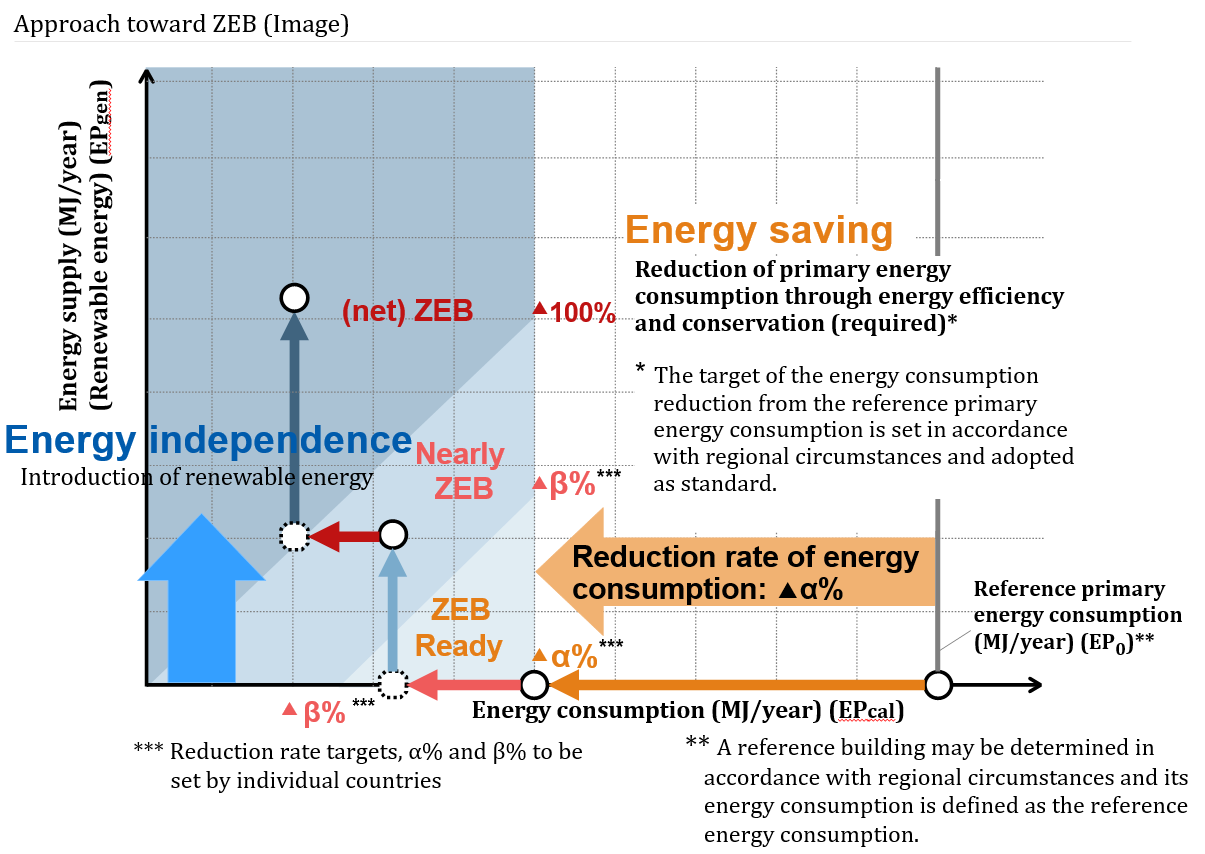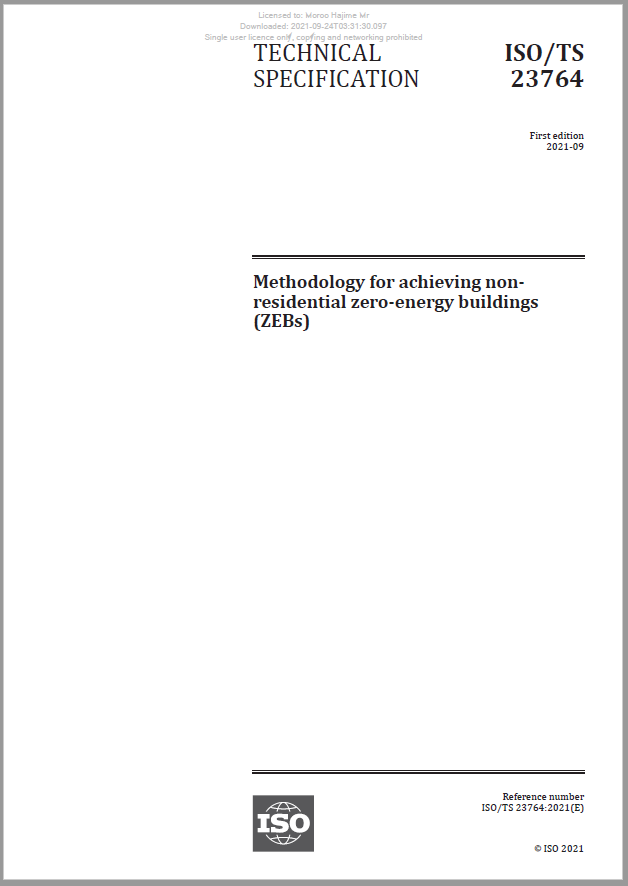September 30, 2021Others
ISO Publishes Technical Specification for ZEB Promotion Formulated by JASE-W, in which AGC Participates
AGC (Headquarters: Tokyo; President: Yoshinori Hirai), a world-leading manufacturer of glass, chemicals, and high-tech materials, has announced that the "Methodology for achieving non-residential zero-energy buildings" proposed by the Japanese Business Alliance for Smart Energy Worldwide (JASE-W), in which AGC participates, was approved by ISO*1 as Technical Specification TS23764 and published on September 24, 2021. The publication of this technical specification is expected to lead to the diffusion of ZEB*2 worldwide and to the reduction of greenhouse gases (GHGs) on a global scale.
JASE-W (Chairman: Masakazu Tokura, Chairman of the Japan Business Federation (Keidanren)) aims to contribute to the reduction of GHG emissions through the excellent energy-saving technologies and products of its member companies. In this way, the public and private sectors are aligned in the promotion of energy-saving and renewable energy technologies in countries around the world, particularly in fast-growing regions.
In 2017, to promote the concept of ZEB across countries, primarily in Southeast Asia, the ZEB Dissemination Working Group led by AGC was established within JASE-W, consisting of members including Japanese companies with advanced technologies in design, air conditioning, elevators, engineering, etc., as well as supporting participants from the Ministry of Economy, Trade and Industry (METI). The working group is engaged in the diffusion of technologies and know-how to establish non-residential buildings as ZEB, and is working to establish international standards as the basis for formulating relevant policies and measures in each country.
With the support of METI, the working group discussed repeatedly and proposed the Technical Specification TS23764 to ISO in May 2020. The specification approved and issued this time outlines the basic items to be considered in the entire process of ZEB realization, from the design to the operation and maintenance stages. In formulating the specification, the working group referenced the "Step-by-step Approach to Achieving ZEB" of the ZEB Roadmap Examination Committee, which was established under the direction of METI's Agency for Natural Resources and Energy.
With the support of METI, the working group discussed repeatedly and proposed the Technical Specification TS23764 to ISO in May 2020. The specification approved and issued this time outlines the basic items to be considered in the entire process of ZEB realization, from the design to the operation and maintenance stages. In formulating the specification, the working group referenced the "Step-by-step Approach to Achieving ZEB" of the ZEB Roadmap Examination Committee, which was established under the direction of METI's Agency for Natural Resources and Energy.
Under the management policy AGC plus 2.0 , the AGC Group aims to add a plus by providing safety, security, and comfort to society and products that create new value and functions for customers. Based on the technical specification formulated this time, AGC will contribute to GHG reduction and the realization of a carbon-neutral society by providing glass products with higher energy-saving performance in response to the promotion of policies and measures for the diffusion of ZEB in Southeast Asia and other countries.
*1 ISO International Organization for Standardization
*2 ZEB Zero Energy Buildings
Buildings that aim to reduce the balance of primary energy consumption to zero.
Regarding ISO Technical Specification TS23764
Background and purpose of the publication
The building sector accounts for 30% of the world's energy consumption, and expectations for its reduction seems to be increasing [source: IEA World Energy Outlook 2020]. Therefore, reducing GHG emissions from this sector is an important global challenge, which ultimately requires reducing the energy consumption of buildings and balancing it with renewable energy to achieve (net) ZEB.
While the ultimate goal of achieving ZEB is clearly understood, its achievement has been constrained by practical barriers such as high upfront investment. However, due to the long life cycle of buildings, designing and constructing more energy-efficient buildings is not considered a future attempt to reduce GHG emissions, but a present attempt. Therefore, we are facing a challenge to accelerate the movement toward ZEBs.
In this context, TS23764 advocates a step-by-step approach to the realization of (net) ZEB. Its purpose is to embody practical ways to realize ZEBs in order to accelerate the movement toward ZEBs. In other words, this specification proposes a practical ZEB approach and outlines the basic considerations that should be taken into account in the entire process of ZEB realization, from the design to the operation and maintenance stages.
Background and purpose of the publication
The building sector accounts for 30% of the world's energy consumption, and expectations for its reduction seems to be increasing [source: IEA World Energy Outlook 2020]. Therefore, reducing GHG emissions from this sector is an important global challenge, which ultimately requires reducing the energy consumption of buildings and balancing it with renewable energy to achieve (net) ZEB.
While the ultimate goal of achieving ZEB is clearly understood, its achievement has been constrained by practical barriers such as high upfront investment. However, due to the long life cycle of buildings, designing and constructing more energy-efficient buildings is not considered a future attempt to reduce GHG emissions, but a present attempt. Therefore, we are facing a challenge to accelerate the movement toward ZEBs.
In this context, TS23764 advocates a step-by-step approach to the realization of (net) ZEB. Its purpose is to embody practical ways to realize ZEBs in order to accelerate the movement toward ZEBs. In other words, this specification proposes a practical ZEB approach and outlines the basic considerations that should be taken into account in the entire process of ZEB realization, from the design to the operation and maintenance stages.
Six core elements of ISO / TS23764 “Methodology for achieving non-residential zero-energy buildings”
1. At planning stage, to have clear policy to achieve ZEB by the three steps, ZEB Ready → Nearly ZEB → (net) ZEB, but not to achieve it by only one step to (Net) Zero Energy Building.
1. At planning stage, to have clear policy to achieve ZEB by the three steps, ZEB Ready → Nearly ZEB → (net) ZEB, but not to achieve it by only one step to (Net) Zero Energy Building.

Source: ISO TS23764 4.4.4 Figure 3
2. At the design stage, to identify appropriate passive and active design strategies and select proper materials and equipment, which are certified by the domestic standard or international standard, as much as possible.
3. During construction, to install the selected materials and equipment correctly according to the drawings and specifications.
4. After completion of building, to realize the energy consumption targeted at the design stage.
5. After operation start, to inspect actual energy consumption continuously (suitable times per year) whether there is any difference of energy consumption between the targeted at design stage and the measured at actual operation.
6. After the start-up of the operation, to calculate the primary energy consumption periodically by using simulation software, if possible.
3. During construction, to install the selected materials and equipment correctly according to the drawings and specifications.
4. After completion of building, to realize the energy consumption targeted at the design stage.
5. After operation start, to inspect actual energy consumption continuously (suitable times per year) whether there is any difference of energy consumption between the targeted at design stage and the measured at actual operation.
6. After the start-up of the operation, to calculate the primary energy consumption periodically by using simulation software, if possible.
Cover page of TS23764

- Media inquiries
- Kazumi Tamaki, General Manager, Corporate Communications & Investor Relations Division
AGC Inc. - Contact: Tomoko Nakao
- TEL: +81-3-3218-5603
- E-mail: info-pr@agc.com

